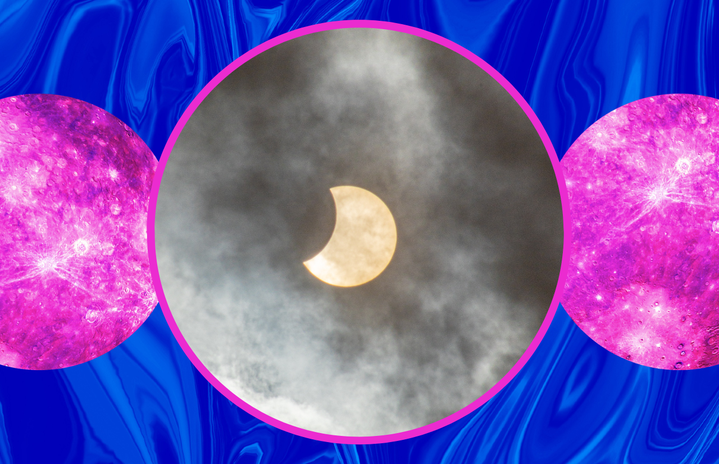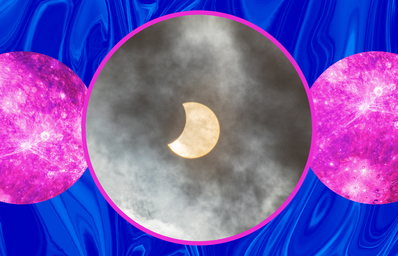The total solar eclipse on April 8th, 2024 is an astronomical event you don’t want to miss. It will be the first total solar eclipse visible in the United States since August 2017 and the next one won’t be until August 2044. “It’s an event that hasn’t happened since 1806 in Ohio and won’t happen again until 2099,” shares Lindsay Deering of the Ohio Department of Natural Resources. Luckily for those of us in Bowling Green, Ohio, we’re right in the path of totality and there’s lots going on at the university to anticipate the event.
What is a solar eclipse?
A solar eclipse is when the moon passes in between the Earth and the sun, briefly covering the sun and darkening the daytime sky as if it were dusk or dawn. Temperatures can drop and animals might get confused by the sudden darkness. Those in the path of a total solar eclipse will be able to view the sun completely covered by the moon and see the outermost part of the sun’s atmosphere called the corona (this effect is called the ring of fire). This April “the path of totality−a 124-mile wide band−will cross Ohio from southwest to northeast,” says Deering. There are several types of solar eclipses: total, annular, partial, and hybrid.
To view the solar eclipse, no matter how close you are located to the path of totality, you must take precautions to avoid burning your retinas. There are no pain receptors in your eye, so you won’t feel the damage being done and there is little that can be done to repair the visual blind spots or distortions (this is called eclipse blindness or solar retinopathy). Do not look at the sun through binoculars, telescopes, cameras, sunglasses.
Here are safe ways to view the solar eclipse:
- Solar eclipse glasses are a convenient and affordable way to view the eclipse. They look similar to anaglyph glasses used to view 3D movies, but eclipse glasses have a protective filter in the lens (this filter is crucial to protect your eyes!). It is actually safe to remove the glasses and directly view the eclipsed sun during the few minutes of total coverage.
- Another way to view the eclipse is to make a pinhole projector. There are several ways this can be done via numerous online tutorials. One way is made using two sheets of paper and a pin: Using the pin, punch a hole in the center of the first sheet. Next, place the second sheet on the ground or prop it up. With your back to the sun, hold up the first sheet and let the light of the sun pass through the pinhole. You should see the sun as a small circle of light on the second sheet. As the moon passes in front of the sun, the circle of light will turn into a crescent. Another way to make a pinhole projector is by using a long box, aluminum foil, sheet of white paper, and a pin. I made one of these box projectors to view the partial solar eclipse in 2017, and here’s written and visual instructions for how to make one: https://scoutlife.org/hobbies-projects/projects/153637/how-to-make-a-solar-eclipse-viewer/.
Meanings behind solar eclipses
In ancient Greek, people believed the eclipse was an omen of bad things to come. The English word “eclipse” even comes from the Greek word “ekleipsis,” which means “being abandoned.”
In ancient China, eclipses were heavenly signs that foretold the Emporer’s future, making predicting eclipses a very important task.
Vikings believed that solar eclipses happened when Sol the sun god got chased by Skoll the wolf. People would bang pots and pans together with the goal of scaring Skoll away.
In Italy, it’s thought that flowers planted during an eclipse grow brighter and more colorfully than other flowers.
Astrology deems solar eclipses as bringers of new opportunities and fresh starts. Solar eclipses are seen as more friendly than lunar eclipses, which are highly emotional and trigger endings or breakthroughs. It is believed that even if you don’t view an eclipse, you will still feel the shift in energy.
Eclipses have been used in literature to symbolize that it is time for change, whether it be for the character, relationship, society, media, etc. Something is usually wrong and in need of a change to fix it. For example, Shakespeare’s Othello (1603) includes an eclipse alongside the tragic marriage of Othello and Desdemona.
Viewing the Eclipse at BGSU
In Bowling Green, Ohio, the eclipse will approximately begin at 2:00pm and end at 4:00pm, with totality occurring from 3:11-3:14pm. College classes will be off for the day so everyone gets a chance to view the eclipse. There will be a large watch party at the Doty L. Perry stadium from 1:00-4:00pm, consisting of “a variety of fun and educational activities, demonstrations, music, telescope viewing, food, and more! Solar eclipse glasses will be provided for safe viewing, free of charge for all in attendance.” Information about the watch party can be found at https://www.bgsu.edu/eclipse.html. Let’s cross our fingers for clear skies that afternoon!
Leading up to April 8th, BGSU has an eclipse speaker series on Thursday evenings at the on-campus planetarium. Topics range from music to literature to history to photography. Find the full list of speaker events at https://events.bgsu.edu/eclipse.
If you are not in the Bowling Green area, here is a list of Ohio National Parks that are offering special programming, free glasses, and food vendors: Alum Creek, Indian Lake, East Harbor, Grand Lake St. Marys, Lake Loramie, Maumee Bay, Hueston Woods, Findley, Geneva, Delaware, Mt. Gilead, Portage Lakes, Headlands Beach, Sycamore, Wingfoot Lake, Van Buren, Punderson and Mohican. Admission to Ohio’s state parks is FREE, but be mindful that most overnight camping spots are already booked. If you aren’t up for the crowds, perhaps you’ll have a good view from your own backyard.
No matter where you watch, have fun and be safe!
sources and further reading
https://science.nasa.gov/eclipses/types/
https://www.exploratorium.edu/eclipse/how-to-view-eclipse
https://www.farmersalmanac.com/the-astrology-of-eclipses
https://www.vox.com/culture/2017/8/18/16158544/solar-eclipses-science-fiction


